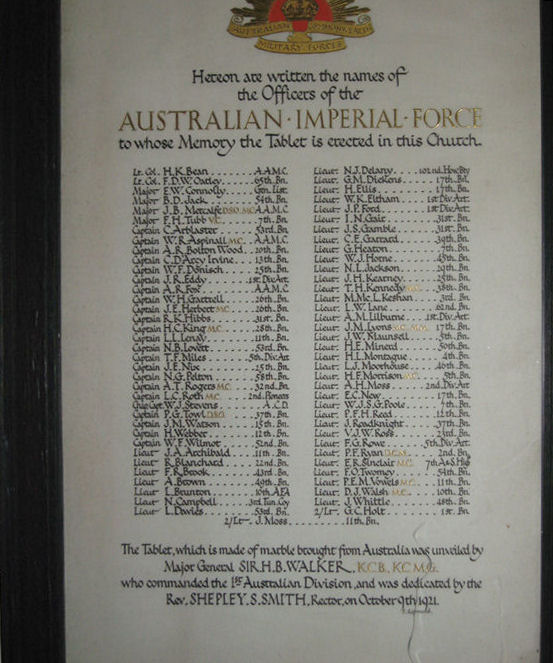Name
Philip Edward Michael Vowels MC
Conflict
First World War
Date of Death / Age
11/05/1918
27
Rank, Service Number & Service Details
Lieutenant
729
Australian Infantry, A.I.F.
11th Bn.
Awards: Service Medals/Honour Awards
1914 /15 Star, British War and Victory medals
Military Cross and Bar
Cemetery/Memorial: Name/Reference/Country
BORRE BRITISH CEMETERY
I. A. 33.
France
Headstone Inscription
IN FOND MEMORY OF MY DEAR SON HAVE MERCY ON HIM O LORD
UK & Other Memorials
Digswell House Australian Hospital Memorial, St John's Church, Digswell
Pre War
Philip Edward Michael Vowels was born on 7 September 1891 in Horsham, Victoria, the son of William and Bridget Vowels. He was educated at St Michael's School, Horsham, Victoria. He lived at 407 William Street, Perth, Western Australia and worked as a ironmonger.
Wartime Service
Having served for 5 years with Goldfields Infantry Regiment, he enlisted on 7 September 1914 at Helena Vale, Western Australia and was given the rank of Sergeant with the 11th Battalion, F Company. His unit embarked from Fremantle, Western Australia, on board HMAT A11 Ascanius on 2 November 1914. He embarked from Alexandria to join the Gallipoli Campaign on 2 March 1915. He was admitted to HS Newmarket, Gallipoli on 10 June 1915 with a heart problem and transferred to other hospitals at Heliopolis and Helouan and eventually discharged to duty on 6 July and re-joined his unit in Gallipoli on 13 July. He was commissioned as 2nd Lieutenant with the 11th battalion on 4 August 1915. At the end of August he suffered from diarrhoea, was transferred to HS Neuralia on 2 September, then to Blue Sisters Hospital in Malta on 10 September and invalided to England on 17 September.
He was placed on the supernumerary list on 20 January 1916 and by 16 March was found fit for general service by a Medical Board at Weymouth. He proceeded to France on 10 April 1916 and joined the 11th Battalion, C Company, in the field on 8 June 1916. He was wounded in action on 24 July 1916 from gun shot wounds to his legs and again invalided to England, to the 4th London Hospital , Denmark Hill by 30 July 1916. He had recovered by 21 August and was on command at the School of Instruction at Kandahar Barracks on 31 October 1916.
On 20 February 1917 he was again sent to France and wounded in action on 16 April 1917 with a severe gun shot wound to his arm. He was transferred to hospital in Rouen the following day and sent to the 3rd London General Hospital, Wandsworth on 22 April 1917, being appointed Lieutenant on 30 April 1917. He was sent to Digswell House (5th Auxiliary Hospital) on 11 May 1917 for convalescence and discharged at the end of the month. He went to the Overseas Training Battalion on 12 July 1917 and then to France to re-join the 11th Battalion in the field on 4 August 1917.
On 4 December 1917 he was admitted to 2nd Australian Field Ambulance with pyrexia (high temperature) of unknown origin and was transferred to Boulogne and discharged 10 days later, being granted 14 days sick leave in England. He re-joined his Battalion on 28 December. He was detached to the 4th Army School of Instruction on 9 February and re-joined his Battalion a month later.
He was awarded the Military Cross and a Bar to the Military Cross.
'For conspicuous gallantry and devotion to duty. He led his men with great dash and skill against two enemy machine gun positions, and captured them under heavy fire. When the objective was reached he showed a coolness and determination during the consolidation, under heavy fire, which was an example to all.' Source: 'Commonwealth Gazette' No. 120. Date: 7 August 1918
'For conspicuous gallantry and devotion to duty. With thirty N.C.O.s and men he carried out a raid which, owing to his previous thorough reconnaissance and able leadership, was a complete success. Without suffering a casualty, he inflicted heavy losses on the enemy and brought back fifteen prisoners and one machine gun.'
Source: 'Commonwealth Gazette' No. 150
Date: 24 September 1918
He was killed in action on 11 May 1918.
Acknowledgments
Brenda Palmer
aif.adfa.edu.au



